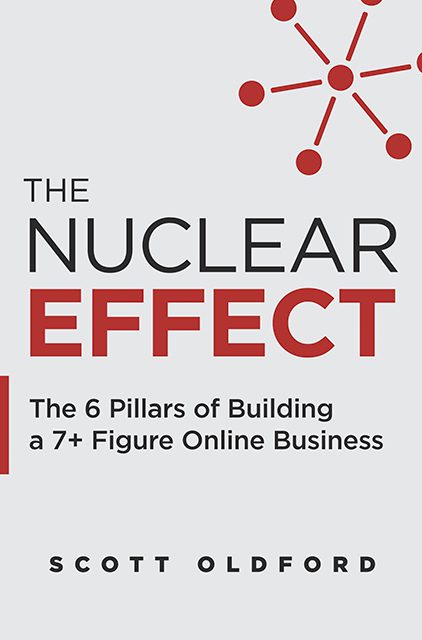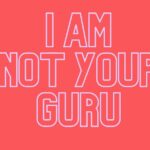In The Nuclear Effect: The 6 Pillars of Building a 7+ Figure Online Business, author Scott Oldford describes six pillars of sustainable growth, you will create the momentum your business needs to become an unstoppable force.
The Nuclear Effect
The Nuclear Effect got its name because its impact on a business is similar to that of one of the most powerful forces known to mankind: the nuclear chain reaction. A nuclear chain reaction is when the initial nuclear reaction produces particles called neutrons. When these particles then harness some of the initial reaction’s energy to set off their own subsequent nuclear reactions, the possibility for a (potentially endless) series of self-sustaining reactions is created. This nuclear chain reaction ultimately is responsible for exponentially increasing the amount of energy created and released from the initial effort. In fact, a nuclear chain reaction releases several million times more energy than any chemical reaction in history.
PILLAR 1: MARKETING AND LEAD GENERATION
Successful marketing that consistently generates qualified leads is the lifeblood of your business. It’s a massive part of what The Nuclear Effect is, and without it, you’ll always come up short (while adding a lot of stress). Unfortunately, many entrepreneurs choose hustling as their main marketing strategy. Either that or they rely on unpredictable lead sources, like organic social media, networking, referrals, or various outbound sales efforts. Or if you have some type of marketing that works, you rely on a single source of new potential business—that’s a huge no -no. The only way off of that emotionally abusive ride is to install an automated, predictable, and scalable source of new quality leads.
The Relevancy, Omnipresence and Intimacy Marketing & Sales Method.
PILLAR 2: SALES
While it is great to be able to attract a growing stream of qualified leads to your business, you’re ultimately wasting the fruits of your marketing efforts if you aren’t able to powerfully (and consistently) enroll them into your product, service, program, or event. There is nothing worse than squandering the opportunity to solve a painful problem for someone (and getting paid well to do it).
PILLAR 3: PRODUCT
In order to really thrive, your business needs a product that delivers a ton of value in a systematic way for your clients. That means your business is creating powerful results for people without relying so much on you to deliver those results. Poor product design is one of the major reasons why talented entrepreneurs get stuck on the hamster wheel. By redesigning the things you offer to the market, you can create greater leverage for yourself (as well as greater profitability for your business).
PILLAR 4: OPERATIONS AND TEAM
Solid operations are THE thing that will allow you to truly scale your business. Even if you had an endless line of people beating a path to your door trying to hurl their credit cards at you to buy your Product(s), your business would break from trying to take on more clients than its operational capacity could handle. Lots of businesses die not of starvation, but rather, they die of the indigestion that follows reckless growth efforts. The mild symptom of this is the feast -and -famine cycle in which you sell a whole bunch only to then realize your current team and operations aren’t equipped to deal with supporting this many clients.
PILLAR 5: FINANCES
Businesses die for three main reasons. They starve from not making enough sales, or they die from indigestion from trying to grow too fast, or they die due to poor financial planning and management. As an entrepreneur, you don’t need to have a CFO level understanding of Finance, but there are a small handful of key things to know that will help you consistently make intelligent financial decisions.
PILLAR 6:
MINDSET We entrepreneurs have a powerful ability to create. And the direction you have your thoughts, vision, and Mindset pointed toward inevitably shows up in the actions you take and creates the results, the business, and the life you are currently experiencing.
The truth in life is that no matter how successful you become, there is always another level. And no matter how much you grow, there will always be thing(s) you struggle with.
R.O.I. STANDS FOR RELEVANCE, OMNIPRESENCE, AND INTIMACY
- Relevance refers to the quality of the messages you’re sending. It’s how you win attention, it creates the way your business is positioned in the minds of others, and it determines how the offer(s) you make to the market are received. It’s what you are saying to your market that attracts people into your world. It’s what compels them to invest with you to help them solve their problem(s) or deliver some desired result(s). It’s what allows someone to say, “This is for me.”
- Omnipresence is the strategic distribution of your message, brand, and marketing. When your audience feels like everywhere they look, there you are. And beyond being merely always present, they come to realize that they are always learning something valuable from you or seeing examples of the kinds of results you deliver or are feeling more and more connected to you as a person , basically, through your regular ability to share your messages with the people in your audience, you become incredibly Relevant to and intimate with them. Omnipresence essentially is an amplifier of your Relevance and your Intimacy, building those two things in an automated, systematic fashion. When executed really well, you can be incredibly precise in what you are sharing and to whom so that the people in your audience feel like you are reading their minds when it comes to the messages they see from you. It’s what allows someone to say, “This was meant for me.”
- Intimacy is the element of real, human connection in your marketing, and it’s the piece that I feel entrepreneurs miss the boat on the most. Nothing makes business happen and money move faster than trust. And the fastest way to build trust is through inviting others to share greater Intimacy with you. You do this when you show up consistently to share value with your audience, when you are transparent and authentic in the messages you share, and when time is spent to build actual relationships with the people in your audience. When you foster real connections with people (and even better when you facilitate an active community for them to engage in), you will be floored by how much easier sales are to make. This is what allows someone to say, “This person is like me, I want to work with them.”
The SSF Method,
A method for understanding the Mindset of those who want to buy your products and services. It stood for The Sidewalk, Slow Lane, Fast Lane Method – The Millionaire Fastlane.
1. THE SIDEWALK
People on the Sidewalk are not ready to buy what you have to offer. So much so that any sort of message about your offer, product, or solution will be ignored. In fact, Sidewalkers often are not even aware that they have the pain or problem that you help solve. While the symptoms of the problem are showing up in their business or their relationships or their health or in other areas of their life, they simply don’t feel it, think about it, or perceive it to be that bad . Either that or they are currently resigned to the belief that it’s the way it is and that there is nothing that could be done for it to change for them . For someone on the Sidewalk to move to the Slow Lane, they need education, illumination, insight, or revelation. They need to clearly see that the problem exists and begin to understand how much it is costing them to allow the problem to persist. Once that happens, they are now problem-aware and become open to finding the right solution for them to take care of it.
2. THE SLOW LANE
Humans are hardwired to want to solve problems. Once a person becomes truly aware of a problem (and sees how it is creating unwanted outcomes in their life), they start looking for ways to resolve it, even if only on a subtle, subconscious level at the start. While Slow Laners aren’t yet actively hunting for and vetting potential solutions, they are now receptive to consuming messages about potential solutions. These messages are now Relevant to them. Even with this increased openness, it still isn’t yet time to really start selling your offer. What needs to happen here for Slow Laners is they want to know there is some sort of proven method or process that has worked for other people with the same problem to solve it. They are looking for an authority they can trust to help them bridge the gap between where they are and where they want to be. This is a huge part of why your positioning is so important.
3. THE FAST LANE
Once someone can understand their problem and can see a potentially viable solution, they are firmly in the Fast Lane. But people don’t stay in the Fast Lane for very long. It would be too painful and emotionally draining to stay in a spot of being highly ready to do something about a problem but not actually doing something about it. One of two things will happen: they’re going to research, vet, and ultimately choose a solution, or they’re going to convince themselves that the problem isn’t that bad right now, to the point where they decelerate back into the Slow Lane. This means that you have a limited window of opportunity to effectively present your solution that will satisfy them both logically and emotionally, and position you as the authority who has the method that is best suited to solve this problem for them.
Positioning is sort of like sex when you’re sixteen—you know you want it; however, you really don’t have much ability to understand how to get it
Painkiller vs Vitamin
Far too many businesses and business models are based on something that is a vitamin instead of a painkiller.
If your business is based on something that is nice to have, it’s going to be difficult. If you’re simply giving an improvement and not a transformation in someone’s life, business, or relationship, you will be the first thing they cut and the last thing they buy. You will have to struggle to get someone to invest in you, regardless of how famous you are, regardless of your results, and regardless of how many marketing messages you put in front of them. The harsh reality is that most entrepreneurs are selling vitamins, and those are much harder to sell than painkillers.
It’s essential that your product or service is a painkiller. And this can be tricky because oftentimes the real pain your market is suffering from is not the same as the perceived pain they think they have. In order to be successful and remain in integrity, you will often need to sell them what they want and deliver what they need. Or sometimes people need to buy something that solves the problem they think they have before they can fully appreciate and understand the real problem(s) that lie underneath.
You either need to devise a way to demonstrate how it truly is a painkiller, OR you need to refocus the Product to address the things that your market does feel a level of urgency and pain around.
THE THREE DIFFERENT TYPES OF OFFERS
Core Offer
Your Core Offer is your initial offering, and it should have a single, clear outcome. The goal for the Core Offer is to give your client a major boost toward their ultimate goal over the course of the first twelve weeks (which is essentially a ninety -day sprint). The promise is to get them through the first major hurdle(s) on the way to the ultimate goal they want to achieve. This offer provides not just some powerful results for the client but also functions as a trial period. Here you get to decide whether the client is someone you would want to work with long term or not. Most of the time, the true ultimate goal that people value enough to pay truly high ticket sums for takes longer than twelve weeks to fully realize. Because of that, the Core Offer flows directly into the Ascension Offer.
When your Core Offer consistency lands people in the right position where they see it as a no-brainer to keep working with you, you know the design for the Core Offer is on point.
Ascension Offer
The Ascension Offer takes the successful clients from your Core Offer and helps them achieve their much bigger goal. This is their ultimate goal—the real outcome that they are truly after. Obviously, it varies greatly depending on the goal, but for example’s sake, let’s say these bigger goals take approximately a year to accomplish (if they are undertaken with focus and intention). This Ascension Offer is going to be a step -up in terms of the value promised and in terms of the commitment required from the client.
Both their financial as well as energetic commitment—remember that the depth of someone’s transformation is almost always correlated to the strength of their commitment and their intention.
The Inner Circle Offer
The Inner Circle Offer is an unadvertised, highly Intimate program for a very few, select clients. Clients at this level typically have an exclusive level of access to you, and this usually includes at least one or two private days or small group Mastermind events. Your Core Offer and the Ascension Offer should be designed to scale . But the Inner Circle Offer is designed to be limited and exclusive and intimate. The Inner Circle Offer comes with a significant investment and is reserved only for people who you would be thrilled to spend that much time and energy with (whether you were getting paid for it or not).
THE THREE ROLES AN ENTREPRENEUR CAN PLAY IN THEIR BUSINESS
The three personalities are the starter, the operator, and the scaler.
- A starter is someone who’s really good at sourcing ideas and implementing the best ones with speed and momentum. Many entrepreneurs are starters. They’re good at quickly deploying new things, getting traction quickly, and building MVPs to validate their ideas.
- An operator is someone who can steadily operate a business that’s already gotten traction. They’re enormously talented at finding and fixing the problems that plague businesses as they navigate growth. They’re incredible at identifying processes, systematizing things, and making the operations of the business smooth and seamless.
- The Scaler: These entrepreneurs have a special skillset that allows them to take an existing business that’s operating well and grow it exponentially. While a starter can typically get a business from zero to the six-figure range (and sometimes to the seven-figure level), they often get stuck there. A scaler’s specialty is taking a business that’s already successful and multiplying on that success. A good scaler will help you begin generating unprecedented year-over-year growth in both revenue and profit.
Knowing your role is critical for understanding exactly what you should be DOING with your time and energy for the business because it’ll allow you to know the right people to hire.
TASK VS. PROJECT VS. OUTCOME HIRING
There are three different types of people that you can hire inside of your business. Most entrepreneurs don’t know the difference, and because of this, they have a completely different expectation, and then the reality isn’t that great for them.
- Task: People who you hire for tasks, you are telling them to do something, you’re giving them a specifically designed task that takes someone to do it (and is not automated), and they are accomplishing that task and then moving onto the next task. For example: publish a new blog post on my website using our Standard Operating Procedure.
- Project: This person is managing or completing an entire project, so this might be developing a marketing funnel or implementing The Relevancy, Omnipresence and Intimacy Marketing & Sales Method, designing or developing landing pages, emails, and getting something done that goes beyond a task.
- Outcome: This person is actively creating a result, for example, giving the person the outcome of producing 10,000 qualified leads a month.
Most businesses are bottom-heavy and have too many task -based team members because they are far more affordable than project or outcome roles. However, who is going to get something done better? The person who is outcome -based , project -based , or task -based ? The more ownership someone has over what they are doing and the more connected to the outcome, the better the result for you as an entrepreneur.
All the Best in your quest to get better. Don’t Settle: Live with Passion.



Comments are closed.